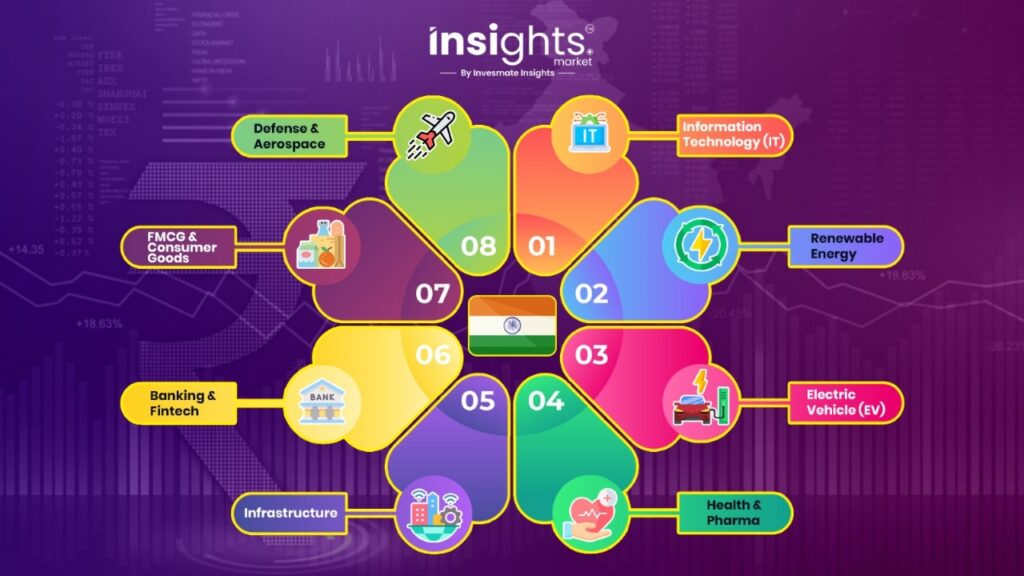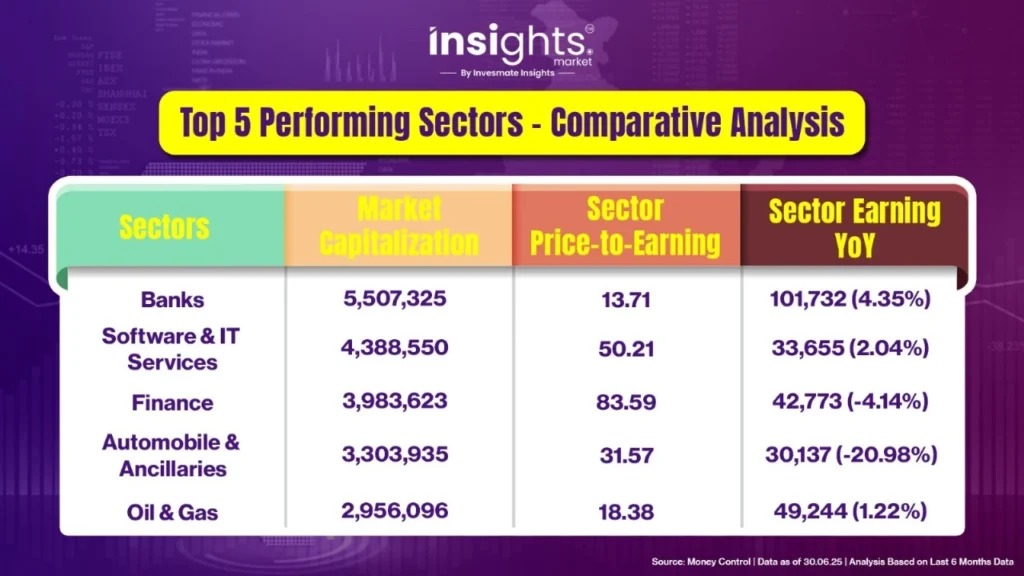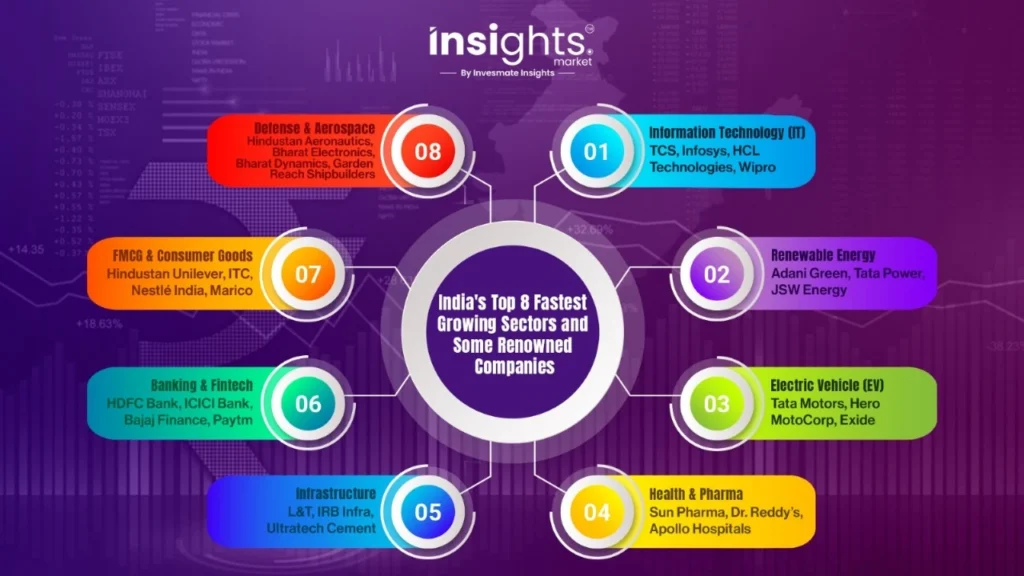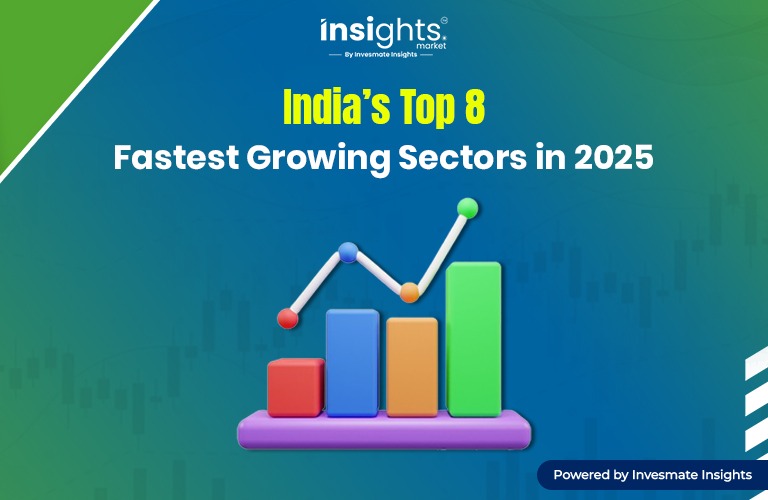![]()
Are you planning to invest in the Indian stock market?
Then ask yourself these questions: Which sectors in India are growing the fastest? Why do these sectors show so much promise? And how can you capitalize on this growth?
Let’s explore the answers.

India’s economy is growing at a rapid pace in 2025. Due to the surge in digital adoption and government-led incentives in key industries, certain sectors are expanding much faster than others. If you are planning to invest in the Indian stock market this year, then the following sectors appear to be the most promising.
In this blog, we’ll discuss the Top 8 Fastest Growing Sectors in India in 2025, driven by strong market demand, favorable policies, and future-ready business models.
Why are these sectors growing so rapidly?
A strong foundation is being created by four key pillars:
- High growth in India’s Gross Domestic Product (GDP),
- Government reforms,
- A young, dynamic workforce,
- Rapid digitalization.
Additionally, government focus on green energy, smart infrastructure, and financial inclusion is opening up several new industrial opportunities.
1. Information Technology (IT)
India continues to be one of the largest global providers of IT services. Moving beyond basic outsourcing, Indian IT firms are now focusing on advanced solutions such as:
- Cloud Computing
- Artificial Intelligence (AI)
- Cybersecurity
- Automation
Growth Drivers:
- Global demand for digital transformation
- Expansion of cloud solutions and digital infrastructure
- Rapid adoption of AI and Machine Learning
- Growing importance of cybersecurity
- Investments in automation and data analytics
Future Potential: According to NASSCOM, India’s IT and Technology sector is expected to reach $500 billion by 2030.
Also Read: Will India’s 8% Growth Be a Myth or a Milestone for Your Job, Business, and Wallet?
2. Renewable Energy
India is aiming to generate 500 Gigawatts of renewable energy by 2030. Major investments are being made in solar power, wind power, and battery storage, supporting both energy security and eco-friendly goals.
Growth Drivers:
- ESG (Environmental, Social & Governance) compliance
- Government incentives and subsidies
- Growing demand for green power by corporates
- Alignment with global climate action goals
Future Potential: Over $250 billion is expected to be invested in this sector by 2030, making it a major driver of India’s economy over the next decade.
3. Electric Vehicles (EVs)
India’s transport sector is undergoing a revolution with the rise of EVs. Factors such as rising fuel prices, pollution concerns, and demand for green technology are driving this shift.
Government initiatives like FAME II (Faster Adoption and Manufacturing of Hybrid and Electric Vehicles) are providing subsidies, tax benefits, and better charging infrastructure.
Growth Drivers:
- Government subsidies and tax relief
- Advancements in charging and battery technology
- Increased demand for e-scooters, buses, and cars
- Consumer preference for eco-friendly transport
Future Potential: India’s EV market is projected to grow at a 44% CAGR until 2030, indicating tremendous growth in the coming years.
Also Read: Understanding Value Investing: A Simple Guide for Beginners
4. Healthcare and Pharmaceuticals
Post the 2020 pandemic, the healthcare and pharma sectors have entered a new era. People are more health-conscious, and the government is heavily investing in medical infrastructure. Moreover, Indian pharma products are gaining strong global demand.
Growth Drivers:
- Government schemes like Ayushman Bharat
- Global demand for Indian medicines and vaccines
- India’s leadership in generic drug manufacturing
- Growth in telemedicine, diagnostics, and medical tourism
Future Potential: The Indian pharmaceutical market is expected to reach $130 billion by 2030, positioning India among the world’s top pharma producers.

5. Infrastructure and Capital Goods
India is witnessing rapid urbanization and expansion in smart city and real estate projects. Central and state governments have allocated large budgets and are partnering with private investors, boosting infrastructure momentum.
Growth Drivers:
- Expansion of the Smart Cities Mission
- Large-scale investments in expressways, metro, and rail projects
- Boost to housing and real estate
- Fast-tracking projects through Public-Private Partnerships (PPP)
Future Potential: This sector is expected to grow at an 8–9% annual rate over the next 5 years, offering long-term stable investment opportunities.
Also Read: What is the Difference Between FPI and FDI?
6. Banking and Fintech
India’s banking and fintech sectors are undergoing major transformation in 2025. Platforms like UPI, Neo-banks, and digital lending have revolutionized financial services. Cashless transactions have now become a part of everyday life.
Growth Drivers:
- Expansion of UPI and digital wallets
- Easier access to loans via neo-banks and fintech apps
- Popularity of InsurTech and micro-investment platforms
- RBI’s initiative on Central Bank Digital Currency (CBDC)
Future Potential: India’s fintech market is projected to reach $1.3 trillion by 2025, making it one of the most profitable sectors for investors over the next decade.
7. FMCG and Consumer Durables
With rising income levels and lifestyle changes in both urban and rural areas, demand for FMCG and consumer durables has seen a significant boost. From daily-use items to home appliances, consumer interest continues to grow.
Growth Drivers:
- Deeper penetration in rural markets
- Increased demand for health-conscious products
- Availability through e-commerce and delivery apps
Future Potential: India’s FMCG sector is expected to grow at a 27.9% CAGR, while the consumer durables sector is projected to grow at 11% annually by 2030.
Also Read: Dabba Trading: An Illegal and Risky Trend in India’s Stock Market
8. Defense and Aerospace
The “Atma Nirbhar Bharat” initiative and relaxed foreign investment norms have strengthened this sector. Focus is on domestic defense manufacturing, which is also opening up export opportunities.
Growth Drivers:
- Emphasis on indigenous production
- Increased defense budgets
- Rising defense equipment exports
Future Potential: India targets $25 billion in defense manufacturing by 2025, making it an emerging opportunity for investors.

Conclusion
The biggest drivers in India’s stock market will be sectors aligned with innovation, sustainability, and inclusive growth. Before investing, keep these points in mind:
- Diversify your portfolio across high-growth sectors like IT, Renewable Energy, EVs, Healthcare, Infrastructure, Fintech, FMCG, and Defense.
- Focus on sectors supported by government policy and future demand.
- Explore mid-cap and rising companies with strong business models.
Strategic investments in these fast-growing sectors can make your portfolio more profitable and steady in 2025.
FAQs
Because of rising fuel costs and eco-conscious consumers, the EV sector is gaining popularity. Government support through the FAME II scheme is boosting adoption. A 44% CAGR is expected till 2030.
Post-pandemic health awareness, government schemes like Ayushman Bharat, and India’s global leadership in generic drug manufacturing have all led to strong domestic and international demand.
With large-scale government spending in Smart Cities, expressways, metro, and real estate under PPP models, the sector is expected to grow at 8–9% annually in the next five years.
UPI, Neo-banks, and digital loan platforms are making financial services more accessible. RBI’s CBDC initiative is also pushing Fintech forward.
Due to focus on indigenous production and the “Atma Nirbhar Bharat” mission, this sector has immense growth potential. India targets $25 billion in defense manufacturing by 2025.




